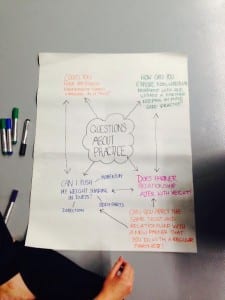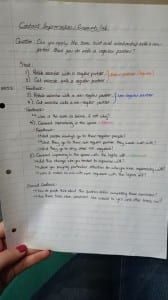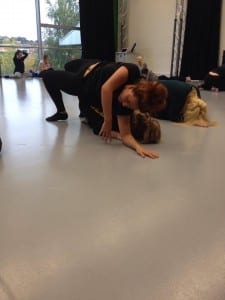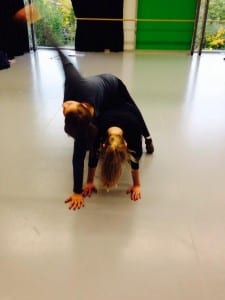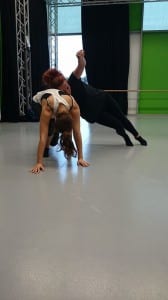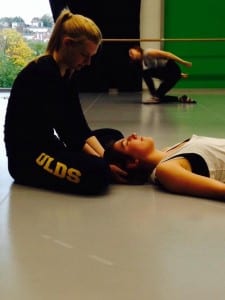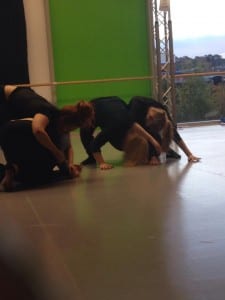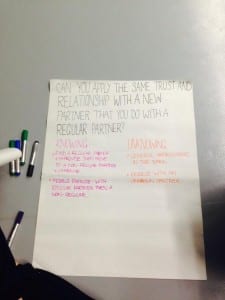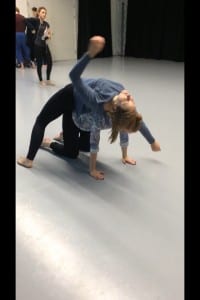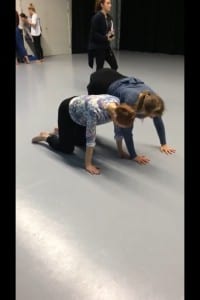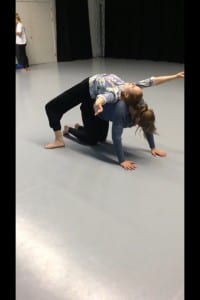Applying what we have learnt in previous lessons, we formulated a question in groups as part of a research lab to see if we could move away from habitual movement and make any new discoveries. We decided on the question ‘Can you apply the same trust and relationship with a new partner that you do with a regular partner?’ We wanted to discover if the movement noticeably changed when working with someone that you don’t know too well or rarely work with in comparison to working with someone that you work with regularly. Additionally, we would to investigate whether their was any differences in trust, such as when you are working with a non-regular partner, are you less reluctant to give them your weight than you are with a regular partner? Or when working with a non-regular partner, do you tend to stick with more safe, habitual movement than you do with a regular partner?
As part of our research lab, we devised a series of tasks to explore this question. We began with the pebble exercise, alternating moving over a known and an unknown partner. In our group there were people I had regularly worked with and people I have rarely worked with before, which made the investigation easier in terms of seeing if there was any difference of I how I gave my weight to different people when moving over them. Each person in the group took turns to roll over each individual in the group. As a collective group, we discovered their was no dramatic difference in how people moved over each different person, which implied there was no trust issue in working with people you haven’t worked with much before. However, the only slight differences that we noticed were that Robyn gave more weight when moving over each person, which suggested that she was more comfortable in carrying out the exercise. Furthermore, Kelly is an individual that I work with regularly but when I was performing the pebble exercise, I found it difficult to decide where to place my weight on her and when working with Toni, who is a partner I less regularly work with, I found it much easier to move over her back, which may because she provided a different physical structure that was easier to move over. Therefore, we decided it may not be the partnership and trust of working with different partners that make movement different but it is up to the how the individual moves and how they place themselves. However, we agreed that we couldn’t formulate a definite answer based on this exercise because the pebble exercise is performed at a low level and it’s not difficult to be trusting in giving someone your weight at a low level because there isn’t a great amount that could go wrong.
We therefore performed the pebble exercise at a higher level, as the person would provide the base on all fours rather than on their knees. However, we carried out this exercise differently, as the person providing the base would close their eyes and try and guess who was moving over them. Our initial prediction was that as the supporter had their eyes closed and the fact that they were at a higher level meant there would be a more hesitant trust. It appeared that each person was quite distinctive in how they moved as the supporter mainly guessed who was moving over them correctly and once again there didn’t appear to be any issue with trust. We then came to the conclusion that trust wasn’t an issue but it appeared to be the way people move and their body shape in which people came distinctive or other’s not so distinctive but everyone seemed quite comfortable moving over each different person. However, we decided that difference in trust may show when more movement appears and the exercises that were performed so far are quite stationary, therefore it’s easier to trust someone.
The next exercise was to explore the cat exercise in regular partners and non regular partners. Firstly, Kelly and Robyn began the exercise as they are quite regular partners. Watching their performance from the outside I could see that they were quite comfortable performing with each other and Kelly closed her eyes when she was dancing, which shows their was trust involved. We developed this exercise by Kelly closing her eyes and me putting my weight in her hands whilst she supported my head as I moved around the space. The feedback we received was that when Kelly was holding my head she was less relaxed and I came across as quite nervous, as I was conscious of where I was moving because Kelly couldn’t see where she was going. However, it was apparent then when our heads connected we both became much more relaxed in our movement. The fact I was quite nervous when Kelly had her eyes closed and was moving my head was particularly strange as I worked with her regularly in contact improvisation. Therefore, we established that trust may not be due to who you are working with but the confidence of the individual and the way they move. This was discovered when Toni and Stacie performed interchanging cat roles and then when Toni and Robyn performed the same exercise. It was noticed that as normal partners Toni and Stacie were quite confident and comfortable performing with each other but Robyn and Toni, unusual partners looked less comfortable. Even though Toni and Robyn are non-regular partners, we began to discover that they became more comfortable in their movement as they went along. We came to the conclusion that it was initially uncomfortable as this was the first time Robyn had performed the exercise, which meant therefore meant she didn’t have a great amount of background knowledge of the exercise so this may have impacted her movement.
To end our investigation, we all participated in a general improvisation taking into account our research question. With reference to Daniel Lepkoff’s: A Question? “If Contact Improvisation is the physical act of posing a question about ones own present circumstance, then the work is ever expansive and has applications to dance well beyond the manifestation of the duet interaction” this statement indicates that there is so much scope to experiment with when relating your movement to a question as it allows you to move away from more habitual movement and explore to your full potential.
In the improvisation task I felt very comfortable performing with everyone and I didn’t think trust was a problem as I felt I gave everyone my weight equally. However, I did feel a slight difference as I felt I move away more habitual movements with regular partners, such as Robyn and Kelly. As a collective group we decided that a jam at the beginning of the research labs may have been beneficial as trust and relationship may have been built up during the course of the investigation so it may have not been a fair discovery. In our discoveries we found that trust is higher at a lower level and it appears that movement is not affected by trust by the way an individual moves and how you connect with them. One of our main discoveries was that relationship was a great impact on movement. Even though we all felt comfortable in giving weight to each other, some of us still felt more confident with working with certain people, even if we haven’t worked with them before. Therefore, it if a partner is confident and if they regularly initiate movement then it’s easier to bounce off them and improvise with them, which creates more comfortable movement. It can therefore be established trust and relationship can be applied equally with any partner if you are confident in your movement and don’t consciously think about what movement you are doing. This relates to Daniel Lepkoff’s statement that “contact improvisation as an art event was to display to the public the body’s innate ability to respond physically to its environment” as posing questions allow you to move away from habitual movement and create new relationships with different people.
In this weeks Jam I believe there was an increase in trust within the group and each member of the group started to perform with different people than they usually do, which has been limited in previous weeks. As we have approached week five, there is a more sense of comfortability within the group as we have been introduced to a number of exercises, which means we have more exploration material. In the Jam I wanted to focus on the question that our group formulated as part of our research lab. I felt that I was more comfortable with working with different people and giving them my weight. For example, usually I am looking to see who I can work with and tend to move towards people that I know well. However, in this jam I focused on not looking for anyone and there was an instance where Beth came up to me and started to move my head around. At the beginning of the contact improvisation this would have made me uncomfortable, as I don’t regularly work with her but it didn’t phase me and I allowed myself to give her my weight and unconsciously move.
Bibliography
Lepkoff, D. (2008) Contact Improvisation: A Question?. [online] Available fromhttp://www.daniellepkoff.com/Writings/CI%20A%20question.php [Accessed 25 October 2014].
Lepkoff, D. (1999) What is Release Technique? [online] Available fromhttp://www.daniellepkoff.com/Writings/What%20is%20Release.php [Accessed 25 October 2014].
